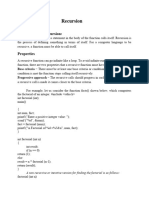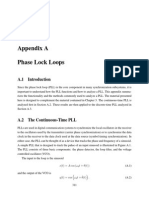Assignment Operators
Uploaded by
naveen reddyAssignment Operators
Uploaded by
naveen reddyAssignment Operators
Opera tor = *= /= %= += = <<= >>= &= ^= |= Meaning Store the value of the second operand in the object specified by the first operand (simple assignment). Multiply the value of the first operand by the value of the second operand; store the result in the object specified by the first operand. Divide the value of the first operand by the value of the second operand; store the result in the object specified by the first operand. Take modulus of the first operand specified by the value of the second operand; store the result in the object specified by the first operand. Add the value of the second operand to the value of the first operand; store the result in the object specified by the first operand. Subtract the value of the second operand from the value of the first operand; store the result in the object specified by the first operand. Shift the value of the first operand left the number of bits specified by the value of the second operand; store the result in the object specified by the first operand. Shift the value of the first operand right the number of bits specified by the value of the second operand; store the result in the object specified by the first operand. Obtain the bitwise AND of the first and second operands; store the result in the object specified by the first operand. Obtain the bitwise exclusive OR of the first and second operands; store the result in the object specified by the first operand. Obtain the bitwise inclusive OR of the first and second operands; store the result in the object specified by the first operand.
You might also like
- Computer Engineering Department TED University: CMPE 252 - C Programming, Spring 2021 Lab 2No ratings yetComputer Engineering Department TED University: CMPE 252 - C Programming, Spring 2021 Lab 24 pages
- Assignment Operators: Op Era Tor Meaning / % + - &No ratings yetAssignment Operators: Op Era Tor Meaning / % + - &1 page
- Faculty of Information Science & Technology (FIST) : PSM 0325 Introduction To Probability and StatisticsNo ratings yetFaculty of Information Science & Technology (FIST) : PSM 0325 Introduction To Probability and Statistics4 pages
- Name Purpose Arguments Non-Mutating Sequence OperationsNo ratings yetName Purpose Arguments Non-Mutating Sequence Operations7 pages
- Class XI: Math Chapter 7: Permutation and Combination Chapter NotesNo ratings yetClass XI: Math Chapter 7: Permutation and Combination Chapter Notes3 pages
- ULO 1d (Differentiation of Algebraic Functions)No ratings yetULO 1d (Differentiation of Algebraic Functions)6 pages
- Introduction To Algorithms: Process of Translating A Problem Into An AlgorithmNo ratings yetIntroduction To Algorithms: Process of Translating A Problem Into An Algorithm17 pages
- COMP6598 - Week 3 - Elementary Programming (Operator)No ratings yetCOMP6598 - Week 3 - Elementary Programming (Operator)34 pages
- Different Complexities With Suitable ExamplesNo ratings yetDifferent Complexities With Suitable Examples27 pages
- ONTO, One To One and Injective FunctionsNo ratings yetONTO, One To One and Injective Functions13 pages
- Pointers: Comp2115 - Information Structures Lecture NotesNo ratings yetPointers: Comp2115 - Information Structures Lecture Notes7 pages
- Advanced Algorithms & Data Structures: Lecturer: Karimzhan Nurlan BerlibekulyNo ratings yetAdvanced Algorithms & Data Structures: Lecturer: Karimzhan Nurlan Berlibekuly47 pages
- Precision Digital Sine-Wave Generation With The TMS32010: Application Report: Spra007No ratings yetPrecision Digital Sine-Wave Generation With The TMS32010: Application Report: Spra00723 pages
- Implementation of An FSK Modem Using The TMS320C17: Application Report: Spra080No ratings yetImplementation of An FSK Modem Using The TMS320C17: Application Report: Spra08062 pages
- Creating A Two Channel Sine Wave Generator Using The TMS320F240 EVMNo ratings yetCreating A Two Channel Sine Wave Generator Using The TMS320F240 EVM34 pages
- Appendix A Phase Lock Loops: x (t) = A cos (ω t + θ (t) )No ratings yetAppendix A Phase Lock Loops: x (t) = A cos (ω t + θ (t) )36 pages
- Interpolation in Microcontroller Based Instrumentation and Control ProjectsNo ratings yetInterpolation in Microcontroller Based Instrumentation and Control Projects4 pages
- Pasquale Arpaia, Pasquale Cimmino, Fabrizio Clemente, Carmine RomanucciNo ratings yetPasquale Arpaia, Pasquale Cimmino, Fabrizio Clemente, Carmine Romanucci5 pages
- Table 1: Coil Calculations For High Voltage Power SupplyNo ratings yetTable 1: Coil Calculations For High Voltage Power Supply6 pages
- Life Extension Through Charge Equalization of Lead-Acid BatteriesNo ratings yetLife Extension Through Charge Equalization of Lead-Acid Batteries8 pages
- One Piece Design W/ Screw Clamp TerminationNo ratings yetOne Piece Design W/ Screw Clamp Termination1 page




































































